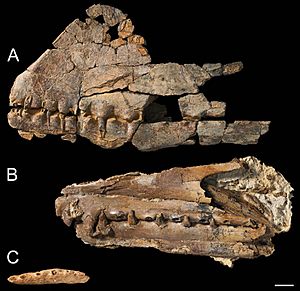Mythunga facts for kids
Quick facts for kids Mythunga |
|
|---|---|
 |
|
| Holotype skull and mandible of Mythunga (B; lower right) | |
| Scientific classification |
|
| Kingdom: | Animalia |
| Phylum: | Chordata |
| Order: | †Pterosauria |
| Suborder: | †Pterodactyloidea |
| Family: | †Anhangueridae |
| Subfamily: | †Tropeognathinae |
| Genus: | †Mythunga Molnar and Thulborn, 2008 |
| Type species | |
| †Mythunga camara Molnar and Thulborn, 2008
|
|
Mythunga is a type of pterosaur, which was a flying reptile. It lived in Australia during the late Early Cretaceous period. This was about 100 million years ago.
Fossils of Mythunga show it lived during the Albian stage of the Early Cretaceous. Scientists believe Mythunga was closely related to another Australian pterosaur called Ferrodraco.
Contents
Discovery and Naming
The only known fossil of Mythunga is a part of its skull. This special fossil is called a holotype and is named QM F18896. It was found in April 1991 by Philip Gilmore. He discovered it in rocks that used to be part of the ocean floor. These rocks are from the late Albian age and are part of the Toolebuc Formation. The fossil was found at Dunluce Station near Hughenden, Queensland, Australia.
The fossil includes parts of the upper and lower jaws. It was found preserved in a chalk rock, keeping its original shape. Scientists believe it belonged to a young, not yet fully grown, animal. The fossil was carefully cleaned and prepared by Angela Hatch of the Queensland Museum. She used special tools and even an acid bath to get it ready for study.
The type species, Mythunga camara, was officially named and described by scientists Ralph Molnar and R. A. Thulborn in 2007/2008. The first part of its name, Mythunga, comes from a local Aboriginal language. It refers to the constellation Orion. The second part of its name, camara, is a Latin word meaning "room." This refers to the air-filled spaces found inside the bones of the pterosaur.
Scientists Adele Pentland and Stephen Poropat studied Mythunga again in 2018. They were able to learn even more about it after the fossil was prepared further. At that time, Mythunga was still the most complete pterosaur fossil ever found in Australia. Only about twenty pterosaur fossils had been found on that continent, and most were just teeth or small bone pieces.
What Mythunga Looked Like
In 2007, scientists first guessed that Mythunga had a wingspan of about 4.7 meters (about 15 feet). This guess was based on the idea that its snout was relatively short.
However, in 2018, scientists looked at the fossil again. They realized that some teeth had been misidentified. They then concluded that Mythunga's skull was likely longer, between 80 centimeters and 1 meter (about 2.6 to 3.3 feet). With this new information, they estimated its wingspan was probably between 4 and 6 meters (about 13 to 20 feet).
Mythunga had some special features that make it unique. One unique trait is that the outer sides of its jaws were wavy. This was because the sockets where its teeth sat bulged outwards.
The preserved part of the fossil is about 26.3 centimeters (about 10 inches) long. Like most pterosaurs, Mythunga's snout was hollow inside. It had a strong internal structure of bone, which helped support it. It had at least eight teeth in each upper jaw and a similar number in its lower jaw. The teeth were relatively short and cone-shaped. They were slightly curved and had an oval shape when looked at from the side. The teeth were spaced out evenly.
Where Mythunga Fits in the Family Tree
In 2007, scientists first thought Mythunga might belong to a very early group of pterodactyloids. Later, in 2010, scientist Alexander Kellner and his team placed Mythunga within a family called Anhangueridae.
In 2018, a detailed study confirmed that Mythunga belonged to the larger group Anhangueria. A study in 2019 by Pentland and others suggested that Mythunga was part of the family Ornithocheiridae. They thought it was a close relative, or "sister taxon," to Ferrodraco.
However, another study in 2020 by Borja Holgado and Rodrigo Pêgas placed Mythunga back in the Anhangueridae family. They believed it belonged to a subgroup called Tropeognathinae. This shows that scientists are still working to figure out the exact family relationships of these ancient flying reptiles.
See also
 In Spanish: Mythunga para niños
In Spanish: Mythunga para niños

